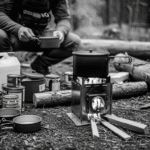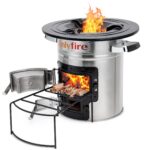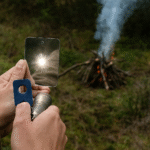
Are You Prepper Or Just Looking To Boil Water During An Emergency? Understanding How To Build A Rocket Stove Is Essential! These stoves utilize easily available materials found around your house for assembly. They make boiling water faster in an emergency!
They’re extremely efficient at using fuel efficiently and can be used both small scale for cooking purposes or larger ones to heat an entire shelter.
1. Tin Can Rocket Stove
Rocket stoves are efficient, inexpensive, and straightforward to build. Their design enables them to use less wood than traditional woodstoves while burning it more effectively – thus reducing smoke, heat loss, pollution, and direct hot air directly to a cook pot on top of the combustion chamber for direct heating of food. Their efficiency makes them perfect for homesteaders, preppers, survivalists and emergency situations such as refugee camps.
Start building a tin can rocket stove by selecting an empty and clean tin can from most grocery stores, typically the size of a coffee can. Make sure the bottom is flat without writing on it; additionally, ensure it has more volume at its base than at its top for adequate chimney space.
Next, cut a small arch out of the bottom of the can so it fits snugly into the stove’s mouth with an equal gap at both ends – this step is essential in making sure your rocket stove works as intended; without this gap it won’t draw enough air in to support a fire.
Once your can is in place, start stacking bricks around it until a structure resembling an outdoor chimney with wire mesh screen at its base is created. At least two feet should be enough height for you to fit a cook pot as well as fuel (tinder/kindling), rocks, cooking utensils/tools etc inside your stove – although do be mindful when handling once lit as the outside can become very hot! For safety precautions make sure that it’s always handled with gloves on to avoid burnt fingers/hands/hands!
2. Rocket Heater
Rocket stoves make great wood-powered heaters when the temperatures drop significantly, keeping you toasty while cooking or taking care of other tasks – plus, they’re more cost-efficient and eco-friendly than using fossil fuels!
One of the easiest and simplest rocket stoves to assemble can be constructed from three metal cans, using one larger can as its exterior surface, one smaller one for its interior chamber, and a third with horizontal opening as feed magazine. Assembling this rocket stove requires only three steps. Plus, this also serves as an effective practice platform before embarking on more durable or sturdy designs!
For those seeking a permanent rocket stove solution, there are various plans online available to them. Some people choose cinder blocks or bricks for aesthetic reasons while ceramic, fire bricks or cob can create more durable models that provide longer-term functionality.
Plans are also available for more advanced metal rocket stoves that require welding skills and more complex assembly methods to build. While this type of rocket stove can be used for cooking food, its primary function is survival heating: keeping you warm in cold environments while using as little wood as possible.
Some prepper websites also provide plans for an economical wood rocket stove using sawdust to form briquettes that can then be placed inside a rocket stove and burned for fuel. This type of stove appears cost-effective enough for survivalists living off grid environments.
3. Trash Can Rocket Stove
An inexpensive and user-friendly option for cooking on camping trips or survival cabin retreats is to use a trash can rocket stove. A rocket stove consists of a horizontal fuel magazine, vertical chimney, and firebox; using just small amounts of wood as fuel creates an extremely hot secondary burn that efficiently heats food being prepared or any other purpose it might serve.
Waste from secondary burns is pulled back into the firebox and burnt with primary fuel, creating very little smoke (and no carbon monoxide) and making for much quicker cooking than an open campfire. Heat is directed directly onto your pot. This method can also provide greater safety for those sensitive to smoke as it provides direct heat delivery directly onto it – ideal for those sensitive to pollution as well as those looking for an efficient method for burning wood.
Make this rocket stove from simple materials found at any dollar store: two cans, tin snips and insulation material (ideally cardboard). There are many methods of assembly; basically you will cut two 28-ounce cans down both sides before inverting one and drilling a hole through both. Once assembled you place another can inside that has had its lid cut off to secure it inside while using the larger can as the chimney and adding cardboard insulation as bottom insulation material.
Metal bucket rocket stoves are another convenient and portable version of this type of stove, though more skill and design knowledge may be necessary for their construction. A rocket mass heater, made out of cement and used for home heating purposes, uses up to eighty percent less wood than traditional wood stoves.
4. Cob Rocket Stove
Cob rocket stoves use a burn chamber made of clay mixed with sand that allows more flexibility when designing its combustion chamber than traditional wood-burning ovens, making this style suitable for camping trips and being built more compactly than usual. They can be equipped with cooking pots on top for direct cooking as well as heating water or dehydrating food products, with some designs even including dehydration capabilities!
Heat risers constructed from metal barrels enclose the combustion chamber, and are often lined with clay and sand insulation, to help retain heat more effectively, which increases stove efficiency but does increase weight. Heat from fire rises along the interior of burn chamber before exiting through an elevated chimney at near ground level for venting to atmosphere – similar to traditional wood-burning stoves but capable of much higher temperatures.
Heat from this source then circulates passively within cob walls of buildings to passively warm them internally. This method can be extremely cost effective and energy efficient, not to mention versatile as its use could include cooking food or radiant heating – features which have been widely embraced by Appropriate Technology concerns and used across third world locales.
Cob rocket stoves don’t produce as much smoke as traditional wood-burning stoves do, yet still produce emissions and require more fuel to reach high heat levels than tin can rocket stoves. Furthermore, maintaining these devices requires more work.
5. Copper Rocket Stove
Copper rocket stoves offer an alternative wood-burning method that’s both elaborate and sustainable, offering reduced greenhouse gas emissions through reduced methane and nitrous oxide releases. They utilize an innovative combustion design which aims to mimic that of a chimney while burning wood at lower temperatures – offering greater sustainability while cutting greenhouse emissions by minimising methane and nitrous oxide release.
Building a copper rocket stove begins by creating its frame out of PVC pipes, followed by packing on a mixture of clay and sand tightly around these pipes to form its mold for the stove. Packing is vitally important so as not to leave air pockets that could compromise its integrity later.
Once your mold for a stove is complete, it is time to construct the actual structure. A coil of copper tubing should be coiled around a PVC pipe before inserting ice into its center to keep from melting away too quickly. Wearing gloves may also come in handy as keeping hands cold can prevent melting of tubing from frozen over.
A basic SR100 rocket stove may cost $1,250 upfront, but you should see considerable savings over time due to reduced heating bills. These stoves also help cut greenhouse gas emissions thanks to more efficient wood-burning methods; with copper coil construction they’re adaptable enough to heat buildings, greenhouses, workspaces and even water heaters!




